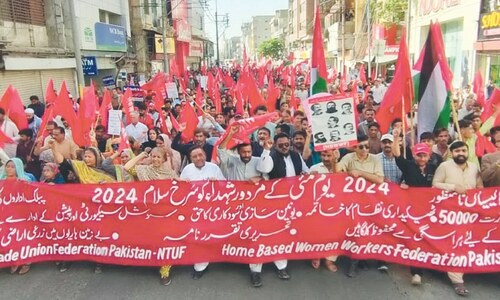ALL those who are trying to look for measures that could help us regain Karachi’s lost architectural glory must also pay heed to the intangible attributes of yesteryear Karachi. This implies that the kind of system that was in place to keep the city clean, both in terms of its built design as well as with regard to having an atmosphere conducive to a pleasant civic life, must be acknowledged. In fact the spirit of the latter is easier to recapture and put to good use.
Today we often hear complaints about the government’s inefficiency in putting away heaps of garbage from different parts of the city. There is some semblance of truth in the grouse because a majority of neighbourhoods are grappling with this problem and the authorities concerned do not seem to have the means to deal with it in quick time and in entirety. Half a century back things were dissimilar. One could argue that in those days the city was not bursting at the seams. Still, compared to contemporary times, the efforts made to rectify things had far more resolve in them. For example, the Karachi Metropolitan had a bevy of refuse vans which constantly moved around the town to look for trash. Not that the issue did not exist at the time, it did. But the Karachi Metropolitan Corporation’s (KMC) reaction would be swift.
On Oct 3, 1966 the newspapers highlighted the situation in Nazimabad saying the streets in the locality were cleaned only once a week, and that too when a KMC inspector visited the area. There were no garbage cans or dustbins which was why sweepers dumped rubbish on roadsides. The KMC took immediate notice of the complaint.
The civic body did not stop there. On Oct 6, it issued a statement saying 10 new refuse vans would shortly be added to the KMC’s fleet of vehicles, increasing their number to 171. The vehicles that were used for removing rubbish from municipal limits included more than 70 vans, over 20 tractors, 45 soil tractors and over 15 cesspool emptiers. The reason for adding 10 vehicles more to the fleet was a few of the old ones, time and again, conked out and ended up in repair workshops.
This was not the only kind of cleanup job that was being carried out that week in Karachi. The same day when the KMC announced the increase in number of the vehicles in its use, the West Pakistan Crimes Branch began a hunt for girl teasers in the city. Policemen wearing plain clothes were posted at bus stops and near girls’ schools and colleges. It seemed, according to one account, that miscreants got wind of the campaign and went into hiding. Although the policemen couldn’t get hold of any boys, the hunt continued for days.
Speaking of hunts, on Oct 8, gold weighing five and a half maunds worth Rs2.2 million was seized by the Sea Customs Anti-Smuggling staff. It was claimed to be the biggest haul seized by the department. The dramatic event led to the arrest of four persons whereas three were still wanted. As per details, a brand new Morris car carrying 18,000 tolas of gold in jackets had been impounded and a search was on for two Volkswagens and a Mercedes which were believed to have been used for smuggling, Customs officials had been hot on the trail of the smugglers for four months.
Published in Dawn October 3rd, 2016














































Dear visitor, the comments section is undergoing an overhaul and will return soon.